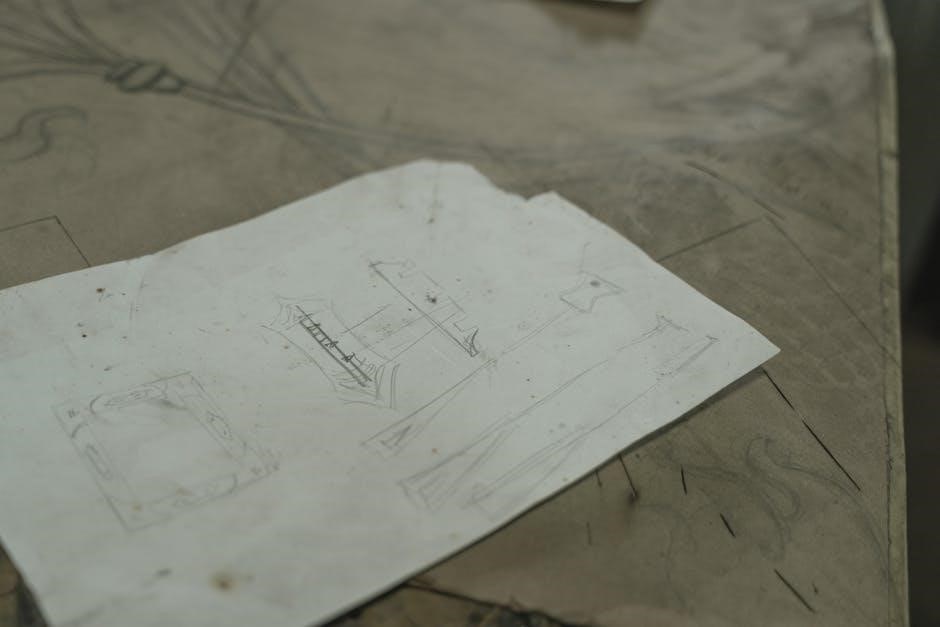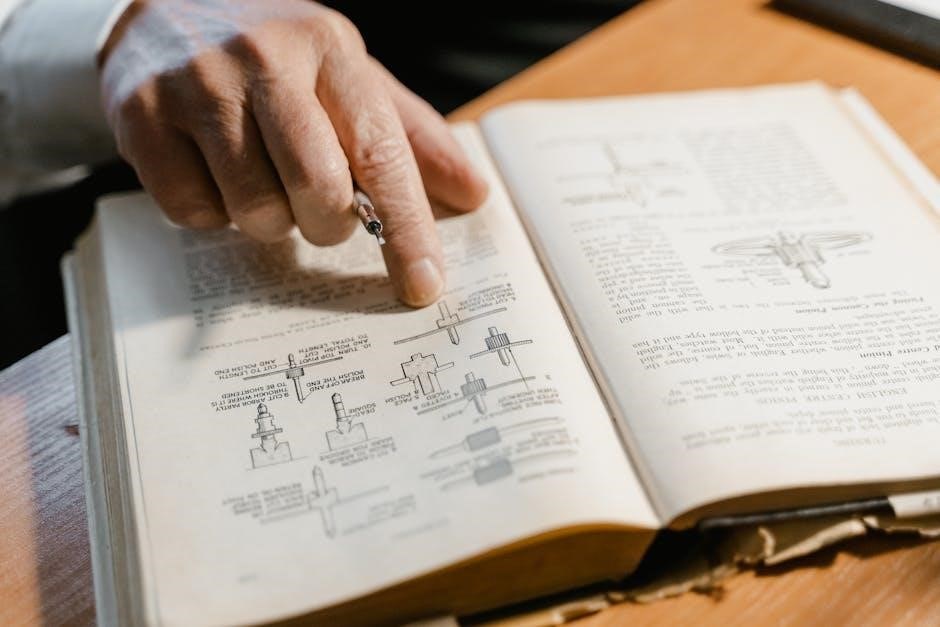Welcome to the Nikon D800 manual, your comprehensive guide to mastering this powerful DSLR camera․ This manual covers key features, setup, shooting modes, and customization options to help you optimize your photography experience․ Designed for both D800 and D800E models, it provides detailed instructions for unlocking your camera’s full potential․ Whether you’re a professional or enthusiast, this guide ensures you make the most of your Nikon D800’s advanced capabilities․ Explore setup, shooting modes, and customization options to enhance your creative workflow and capture stunning images with precision and ease․ This manual is your essential resource for understanding and utilizing the D800’s features effectively, ensuring you achieve exceptional results in every shot․ Discover how to navigate the camera’s settings, leverage its advanced autofocus system, and produce high-quality images consistently․ With this manual, you’ll gain the knowledge to take full control of your Nikon D800 and elevate your photography to new heights․
Overview of the Nikon D800 Camera
The Nikon D800 is a high-performance DSLR camera designed for professional photographers and enthusiasts․ It features a 36․3-megapixel full-frame FX-format sensor, delivering exceptional image detail and clarity․ Built with a durable magnesium alloy frame, the D800 combines robust construction with advanced imaging capabilities․ Its wide ISO range and sophisticated autofocus system make it ideal for various photography genres, from landscapes to portraits․ This camera offers creative control and precision, making it a versatile tool for capturing stunning images in diverse conditions․ The D800’s design and functionality cater to both professionals and serious hobbyists seeking high-quality results․
Importance of Reading the Manual
Reading the Nikon D800 manual is crucial for unlocking its full potential․ This comprehensive guide provides detailed insights into the camera’s features, helping you understand its advanced settings and functions․ By familiarizing yourself with the manual, you’ll discover how to optimize your shooting techniques, customize controls, and troubleshoot common issues․ Whether you’re a novice or an experienced photographer, the manual ensures you make the most of your camera’s capabilities․ It serves as an essential reference for mastering the D800 and achieving professional-grade results in every shot․ Regularly reviewing the manual helps you stay updated on best practices and camera maintenance, ensuring longevity and peak performance․ The manual is your key to unlocking the D800’s true potential and enhancing your photography skills․ By understanding its contents, you’ll be empowered to capture stunning images with confidence and precision․ The manual is an invaluable resource that complements your creative journey with the Nikon D800, providing clear guidance and expert advice․ Embrace the manual as your go-to guide for unlocking the camera’s full potential and achieving exceptional results in every photography session․ Through its detailed instructions, you’ll gain the knowledge needed to harness the D800’s advanced features and take your photography to the next level․ The manual is an indispensable companion for both learning and refining your photography techniques with the Nikon D800․

Key Features of the Nikon D800
The Nikon D800 boasts a robust build, advanced 36․3MP full-frame sensor, precise autofocus, wide ISO range, and versatile shooting modes, ensuring exceptional image quality and flexibility․
Design and Build Quality
The Nikon D800 features a durable magnesium alloy body, ensuring robustness and reliability in various shooting conditions․ Its weather-sealed design protects against dust and moisture, making it ideal for outdoor photography․ The camera offers an ergonomic grip and intuitive control layout, enhancing comfort during extended use․ The 3․2-inch high-resolution LCD screen provides clear image playback and menu navigation․ With its solid construction and user-friendly design, the D800 is built to meet the demands of professional photographers while delivering exceptional performance and comfort․
Image Sensor and Resolution
The Nikon D800 is equipped with a 36․3-megapixel full-frame CMOS image sensor, delivering exceptional detail and rich tonal gradations․ Its high resolution enables capturing sharp images with minimal noise, ideal for large-format printing and cropping․ The sensor’s full-frame design ensures superior light capture, enhancing overall image quality․ With a wide dynamic range, the D800 excels in both bright and low-light conditions, producing vibrant colors and precise contrast․ This advanced sensor technology makes the D800 a powerful tool for professional photographers seeking high-resolution results․
- 36․3-megapixel full-frame CMOS sensor․
- Exceptional detail and rich tonal gradations․
- Superior light capture and wide dynamic range․
- Ideal for large-format printing and cropping․
Autofocus System
The Nikon D800 features an advanced 51-point autofocus system, offering precise and fast subject tracking․ With 15 cross-type sensors, it ensures accurate focus acquisition in various lighting conditions․ The system supports multiple AF modes, including single-point, dynamic-area, and 3D tracking, allowing photographers to capture sharp images of stationary and moving subjects․ Customizable AF settings further enhance flexibility, making the D800 ideal for sports, wildlife, and portrait photography․ Its reliable performance ensures that critical moments are captured with clarity and precision, even in challenging environments․
- 51-point autofocus system with 15 cross-type sensors․
- Advanced AF modes: single-point, dynamic-area, and 3D tracking․
- Customizable settings for enhanced flexibility․
- Excellent performance in low-light conditions․
- Ideal for sports, wildlife, and portrait photography․
ISO Range and Noise Performance
The Nikon D800 offers an ISO range of 100 to 6400, extendable to 25600 in expanded mode․ It delivers excellent noise performance, with minimal grain even at higher ISO settings․ This makes it suitable for low-light photography while maintaining image quality․ The camera’s noise reduction systems ensure clean and detailed images, preserving subtle textures and colors․ Whether shooting in bright sunlight or dim interiors, the D800’s ISO flexibility and noise control provide consistent results, making it a reliable choice for professional photographers․
- ISO range: 100–6400 (expandable to 25600)․
- Excellent noise performance at high ISO settings․
- Advanced noise reduction for clean, detailed images․
- Suitable for low-light and high-contrast scenarios․

Setting Up Your Nikon D800
Setting up your Nikon D800 involves unboxing, charging the battery, and familiarizing yourself with basic controls․ Proper initialization ensures optimal camera performance and functionality․
Unboxing and Initial Inspection
Begin by carefully unboxing your Nikon D800 to ensure all components are included․ Check for the camera body, battery, charger, memory cards, USB cable, and manual․ Inspect the camera for any visible damage or defects, paying attention to the LCD screen and lens․ Verify that all accessories are in pristine condition․ This step ensures everything is accounted for and functional before proceeding with setup․
Charging the Battery and Inserting the Memory Card
To begin using your Nikon D800, start by charging the battery using the provided charger․ Plug the charger into a power outlet, ensuring the battery is properly aligned and secured․ Allow it to charge until the indicator light shows it’s fully charged, typically taking a few hours․ Next, insert the memory card into the camera’s card slot, located on the side․ Open the compartment, align the card with the guides, and gently push it in until it clicks․ This prepares your camera for operation, ensuring you’re ready to capture images with ample storage and power․
Basic Camera Controls and Layout
Familiarize yourself with the Nikon D800’s controls to optimize your shooting experience․ The mode dial on the top left allows you to switch between shooting modes, while the shutter release button is centrally located on the grip․ The rear panel features the multi-selector for navigating menus and selecting focus points․ The live view button and playback controls are also conveniently placed for easy access․ Understanding the layout ensures intuitive operation, enabling you to adjust settings quickly and focus on capturing stunning images with precision and ease․

Shooting Modes on the Nikon D800
The Nikon D800 offers various shooting modes, including Auto, Scene, Aperture Priority, Shutter Priority, and Manual, providing flexibility for photographers to suit different creative needs effectively․
Understanding Auto Modes
The Nikon D800 features multiple Auto modes, including Full Auto and Scene Auto Selector, which simplify photography by automatically adjusting settings for various shooting scenarios․ These modes are ideal for beginners or quick captures, as they allow the camera to handle exposure, focus, and other settings seamlessly․ Scene-specific modes like Portrait, Landscape, and Close-Up further enhance results by optimizing settings for particular subjects․ Auto modes provide a great starting point for mastering the camera’s capabilities while minimizing manual adjustments․
Aperture Priority and Shutter Priority Modes
In Aperture Priority (A/Av) mode, you set the aperture, and the camera automatically adjusts the shutter speed for proper exposure․ This mode is ideal for controlling depth of field, such as blurring backgrounds or keeping landscapes sharp․ Shutter Priority (S/Tv) mode allows you to set the shutter speed, useful for freezing fast-moving subjects or creating motion blur․ Both modes offer creative control while simplifying exposure adjustments, making them versatile for various shooting situations and lighting conditions․
Manual Mode (M)
In Manual (M) mode, you gain full control over both aperture and shutter speed, allowing precise adjustments to achieve your desired exposure․ The camera does not automatically adjust settings, so you must manually set ISO, aperture, and shutter speed to ensure proper exposure․ This mode is ideal for experienced photographers who want complete creative control․ Use the exposure compensation dial to fine-tune settings and rely on the built-in light meter for guidance․ Manual mode offers maximum flexibility but requires a good understanding of exposure principles to use effectively․
Custom Shooting Modes (U1, U2, U3)
Custom Shooting Modes (U1, U2, U3) allow you to save and recall specific camera settings for quick access․ These modes are programmed via the Setup Menu, enabling you to tailor settings like autofocus, metering, and white balance to suit different shooting scenarios․ After configuring, the modes can be renamed for clarity․ This feature is ideal for photographers who frequently switch between setups, such as portrait, landscape, or action photography, ensuring efficiency and consistency in their workflow․ These modes are independent of the standard shooting modes and provide enhanced customization options․

Advanced Shooting Techniques
Master advanced techniques like HDR, bracketing, and focus modes to refine your photography․ Use tools like the histogram for precise exposure control and professional results․
Using the Histogram for Exposure Control
The histogram on your Nikon D800 displays tonal distribution, helping assess exposure․ Peaks on the left indicate underexposure, while those on the right suggest overexposure․ Aim for a balanced graph avoiding clipped shadows or highlights․ Use exposure compensation to adjust settings․ Bracketing captures multiple exposures for later merging․ This tool enhances dynamic range and ensures optimal image quality, guiding precise adjustments for professional results․

White Balance Adjustment
White balance ensures accurate color representation under various lighting conditions․ The Nikon D800 offers multiple presets, including Auto, Daylight, Fluorescent, and Cloudy․ Use the WB button and command dials to adjust settings․ For precise control, set a custom white balance by shooting a reference object (e․g․, gray card) and selecting it in the menu․ This feature minimizes color casts and enhances image fidelity, allowing photographers to capture scenes with natural and consistent tones, especially in mixed or unusual lighting environments․
Bracketing and HDR Photography
Bracketing on the Nikon D800 allows capturing multiple exposures of the same scene at different brightness levels․ This is ideal for high-contrast scenarios․ The camera can shoot up to 9 frames with exposure increments of 1/3, 1/2, or 1 EV․ For HDR photography, merge these images using optional Nikon software or third-party tools․ The D800 also offers in-camera HDR modes, combining exposures to create a single image with expanded dynamic range and enhanced detail in shadows and highlights, perfect for landscapes and architectural shots․
Focus Modes and AF Area Selection
The Nikon D800 offers four focus modes: Single AF (AF-S), Continuous AF (AF-C), Manual Focus (MF), and AF-A, which automatically switches between AF-S and AF-C․ The AF area selection includes options like Single Point, Dynamic Area, 3D Tracking, and Auto Area․ Single Point allows precise focus on a specific subject, while Dynamic Area and 3D Tracking are ideal for moving subjects․ Auto Area lets the camera automatically select the focus point․ These modes and selections ensure sharp focus in various shooting situations, from stationary portraits to fast-moving action․

Custom Settings and Configuration
The Nikon D800 allows users to customize camera controls, create custom shooting modes, and adjust autofocus settings to suit individual preferences, enhancing shooting efficiency and personalization․
Customizing Camera Buttons and Menus
The Nikon D800 allows extensive customization of camera buttons and menus to suit individual preferences․ Users can assign specific functions to buttons like the Fn and Preview buttons, enabling quick access to frequently used settings such as ISO, AF modes, or white balance․ The My Menu feature lets photographers organize and prioritize their most-used settings, streamlining workflow․ This level of customization enhances shooting efficiency and makes the camera more intuitive for personal workflows, ensuring a tailored photography experience․
Configuring Autofocus Settings
The Nikon D800 offers extensive customization of its autofocus system to optimize performance for various shooting scenarios․ Users can configure AF modes (AF-S, AF-C, and AF-A) and AF-area modes, such as Single-point AF or Dynamic-area AF, to suit their needs․ The camera also allows adjusting the AF activation and tracking settings․ Customizing these settings enables precise control over focus acquisition and tracking, ensuring sharp images in both static and dynamic compositions․ This flexibility makes the D800 highly adaptable to different photography styles and subjects․
Setting Up Metering Modes

The Nikon D800 offers multiple metering modes to ensure accurate exposure in various lighting conditions․ The three primary modes are Matrix, Center-weighted, and Spot metering․ Matrix metering analyzes the entire scene for balanced exposure, while Center-weighted prioritizes the central area․ Spot metering measures light from a specific point, ideal for high-contrast situations․ Users can select these modes via the camera’s menu or dedicated buttons, allowing for precise control over exposure settings to match their creative vision and lighting scenarios․

Image Review and Management
The Nikon D800 allows users to review images on its LCD screen, delete unwanted photos, protect important shots, and transfer images to a computer via USB․
Reviewing Images on the LCD Screen
The Nikon D800’s 3․2-inch LCD screen allows users to review images with clarity․ Use the multi-selector to scroll through photos, and press the zoom buttons to enlarge details․ The OK button resets zoom, while the Playback button cycles through display options, including histograms and shooting data․ Use the Delete button to remove unwanted images․ Protect important shots with the Protect feature to prevent accidental deletion․ The LCD also supports RGB histogram and highlight warnings for precise exposure review․
Deleting and Protecting Images
To manage your photos efficiently, the Nikon D800 offers intuitive deletion and protection options․ Press the Delete button to remove unwanted images during playback․ For protection, use the Protect feature, which prevents accidental deletion․ Select multiple images for batch protection or deletion using the Memo menu․ Protected images are marked with a key icon․ Be cautious, as deletion is permanent․ Use these features to organize your memory card and ensure your favorite shots remain safe․ Regularly transfer images to a computer for backup․
Transferring Images to a Computer
Transferring images from your Nikon D800 to a computer is straightforward․ Connect the camera to your PC via the provided USB cable, or use a memory card reader for faster transfer․ Use Nikon Transfer 2 software, available in the ViewNX 2 package, to import photos․ Alternatively, use your computer’s built-in photo transfer tools․ Ensure the camera is in Mass Storage or PTP mode․ For wireless transfer, use the optional WT-4A transmitter․ Always organize images into folders and back them up for safekeeping․ This ensures your photos are securely stored and easily accessible․

Maintenance and Troubleshooting
Regularly clean the sensor and lens to maintain image quality․ Update firmware for optimal performance․ Refer to the manual for troubleshooting common issues and solutions․
Cleaning the Camera and Lens
Regular cleaning is essential to maintain the Nikon D800’s performance․ Use a soft, dry cloth to wipe the camera body and lens surfaces․ For the sensor, use a hand-held blower to remove dust․ Avoid touching the sensor or lens elements, as oils from your skin can cause smudges․ For stubborn spots on the lens, use a microfiber cloth with a small amount of lens cleaning solution․ Never use household cleaners, as they may damage coatings․ Cleaning should be done in a dry, dust-free environment to prevent contamination․
For deep cleaning, activate the camera’s “Clean Sensor” mode․ This vibrates the sensor to remove dust․ If spots persist, consult a professional․ Always store the camera and lenses in a protective case to minimize dust exposure․
Updating Firmware
Updating the Nikon D800’s firmware ensures optimal performance and adds new features․ Visit Nikon’s official website to check for the latest firmware version․ Download the update to your computer, then transfer it to the camera using a memory card․ Insert the card into the camera, navigate to the “Setup” menu, and select “Firmware version” to initiate the update․ Ensure the battery is fully charged and avoid interrupting the process․ After completion, verify the firmware version in the camera menu to confirm success․ Always use official Nikon sources to avoid risks․
Regular firmware updates are crucial for maintaining camera functionality and compatibility with lenses and accessories․ If issues arise, reset the camera or contact Nikon support for assistance․ Never attempt to update firmware during low battery or unstable power conditions to prevent potential damage․
Common Issues and Solutions
The Nikon D800 may encounter issues like memory card errors or autofocus malfunctions․ For memory card errors, format the card in the camera or use a card reader․ If autofocus is slow or inaccurate, clean the lens and camera contacts․ Battery drain can be resolved by turning off unnecessary features like GPS․ If issues persist, reset the camera to default settings via the “Setup” menu․ Always use compatible accessories to avoid conflicts․ Regularly cleaning the sensor and updating firmware can prevent many problems․ Refer to the manual or Nikon support for detailed troubleshooting guides․
Additional Resources
Explore the Nikon D800 PDF manual for detailed guidance, online tutorials for hands-on learning, and Nikon’s official support for troubleshooting and community forums․
Nikon D800 PDF User Manual Download
The Nikon D800 PDF user manual is a comprehensive guide available for free download from Nikon’s official website․ It provides detailed instructions on camera features, settings, and troubleshooting․ The manual is essential for mastering the D800’s advanced functions, including custom settings and shooting modes․ Ensure to download it from trusted sources to avoid security risks․ This digital version allows easy access and reference, making it a valuable resource for both beginners and experienced photographers seeking to optimize their camera’s performance․
Online Tutorials and Guides
Online tutorials and guides for the Nikon D800 are abundant, offering step-by-step instructions and expert tips․ Nikon’s official website, YouTube channels, and photography forums provide extensive resources․ These guides cover topics like camera setup, shooting modes, and advanced techniques․ Many are free, while others require a subscription․ They cater to photographers of all skill levels, making them an invaluable tool for mastering the D800 and enhancing your photography skills․ These resources complement the manual, offering practical insights and real-world applications for getting the most out of your camera․
Nikon Customer Support and Community Forums
Nikon’s official website offers comprehensive customer support, including FAQs, troubleshooting guides, and repair services․ Community forums, such as Nikon Users Group and DPReview, provide platforms for photographers to share experiences and solutions․ These forums are ideal for resolving specific issues or learning tips from experienced users․ Nikon’s customer service team is also available for direct inquiries, ensuring assistance with any D800-related concerns․ Active communities and dedicated support channels enhance the overall ownership experience for Nikon D800 users․
